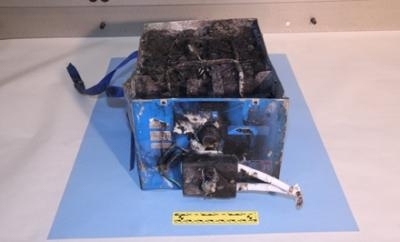Fri, May 23, 2014
Looks At The Power Cells As They Are Used In Aircraft Systems
The NTSB has issued a series of recommendations today related to the evaluation and certification of lithium-ion batteries for use in aircraft systems, as well as the certification of new technology.

The five safety recommendations, all addressed to the FAA, are derived from the NTSB’s ongoing investigation of the January 7, 2013, fire event that occurred in a lithium-ion battery on a Boeing 787 that was parked at Boston Logan Airport.
Investigators found that the battery involved in the Boston 787 fire event showed evidence not just of an internal thermal runaway but that “unintended electrical interactions occurred among the cells, the battery case, and the electrical interfaces between the battery and the airplane.”
The 12-page safety recommendation letter said that the processes used in 2006 to support the certification of the lithium-ion battery designed for the 787 were inadequate, in part, because there is no standardized thermal runaway test that’s conducted in the environment and conditions that would most accurately reflect how the battery would perform when installed and operated on an in-service airplane.
Further, the NTSB said that because there is no such standardized thermal runaway test, lithium-ion battery designs on airplanes currently in service might not have adequately accounted for the hazards associated with internal short circuiting.
In its examination of the challenges associated with introducing newer technologies into already complex aircraft systems, the NTSB said that including subject matter experts outside of the aviation industry “could further strengthen the aircraft certification process” by ensuring that both the FAA and the aircraft manufacturer have access to the most current research and information related to the developing technology.
To address all of these issues, the NTSB asked the FAA to do the following:
- Develop an aircraft-level thermal runaway test to demonstrate safety performance in the presence of an internal short circuit failure
- Require the above test as part of certification of future aircraft designs
- Re-evaluate internal short circuit risk for lithium-ion batteries now in-service
- Develop guidance for thermal runaway test methods
- Include a panel of independent expert consultants early in the certification process for new technologies installed on aircraft
The final report on the January 2013 Boston 787 battery fire investigation is estimated to be completed in the fall.
(NTSB image)
More News
From 2021: The Inside Skinny On What Being An ANN Oshkosh Stringer Is All About By ANN Senior Stringer Extraordinare, Gene Yarbrough The annual gathering at Oshkosh is a right of p>[...]
Video Showed That During The Takeoff, The Nose Baggage Door Was Open On May 10, 2025, about 0935 eastern daylight time, a Piper PA-32RT-300, N30689, was destroyed when it was invol>[...]
Get The Latest in Aviation News NOW on Instagram Are you on Instagram yet? It's been around for a few years, quietly picking up traction mostly thanks to everybody's new obsession >[...]
"I think what is key, we have offered a bonus to air traffic controllers who are eligible to retire. We are going to pay them a 20% bonus on their salary to stay longer. Don't reti>[...]
Aero Linx: Pilot Briefing The gathering, translation, interpretation, and summarization of weather and aeronautical information into a form usable by the pilot or flight supervisor>[...]
 Oshkosh Memories: An Aero-News Stringer Perspective
Oshkosh Memories: An Aero-News Stringer Perspective NTSB Prelim: Piper PA32RT
NTSB Prelim: Piper PA32RT ANN FAQ: Follow Us On Instagram!
ANN FAQ: Follow Us On Instagram! Aero-News: Quote of the Day (05.28.25)
Aero-News: Quote of the Day (05.28.25) ANN's Daily Aero-Term (05.28.25): Pilot Briefing
ANN's Daily Aero-Term (05.28.25): Pilot Briefing



